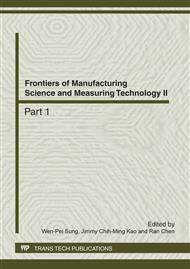p.872
p.876
p.880
p.884
p.888
p.892
p.896
p.900
p.905
Role of Ion Transport in the Actuation of Cellulose Based EAPap
Abstract:
The application of electroative polymer devices requires the availability of their propertis at various operating conditions. Cellulose based Electro-Active Paper (EAPap) has been studied as an attractive EAP material for artificial muscles due to its low cost, availability, light weight, large displacement output, low actuation voltage and low power consumption. It is investigated which the underlying mechanism is responsible for their strain-field response. The understanding of the actuation mechanism of this material is important in order to improve the performance and also to better target the application. To physically investigate the actuation mechanism of EAPap, several tests are performed. TSC current showed an evidence of ionic migration effect. Thus, we conclude ionic migration effect associated with dipole moment of cellulose paper ingredients. These effects maybe depend on environmental condition.
Info:
Periodical:
Pages:
888-891
Citation:
Online since:
April 2012
Authors:
Keywords:
Price:
Сopyright:
© 2012 Trans Tech Publications Ltd. All Rights Reserved
Share:
Citation:


